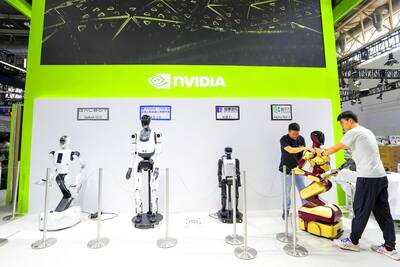The Council of Agriculture (COA) said yesterday that rice flour might be mixed into regular flour as a way to lower the nation's reliance on imported foods, combat rising commodity prices and create ways to diversify rice consumption.
"Being a domestic product, rice has the advantage of being fresh and relatively unaffected by international commodity prices," COA Deputy Minister Yu Sheng-feng (
"Rice prices have tended to be significantly higher than that of flour, but in the recent year flour prices have soared from NT$17 per kilogram to NT$31. After the recent 8 percent increase rice now costs NT$34.5 per kilogram," Yu said.

PHOTO: WANG YI-SUNG, TAIPEI TIMES
In light of increasing rice and flour prices, the council commissioned researchers to develop ways to increase the nation's consumption of rice and its byproducts, he said, adding that the research project had been very successful and was now seeking technical transfers to interested businesses so that more Taiwanese could enjoy foods made from rice.
"So far we have determined a good proportion for mixing rice flour with regular flour, and have developed recipes for bread, noodles, cakes and other baked goods," he said.
Citing a study done by Taipei Medical University, rice is nutritionally balanced, containing 73 to 77 percent carbohydrates, 7 percent protein and 1.5 to 2 percent fat, he said.
"In addition, fibers, minerals and vitamin B are also abundant in rice, which is good for one's metabolism and digestion," he said.
COA Minister Su Jia-chyuan (蘇嘉全) yesterday came under fire over his comment that the rice price had "increased by just 8 percent" compared with the average price in the past three years.
The statement sparked criticism that Su did not emphasize with the economic pressures bearing down on consumers during a time of global financial difficulty.
The minister made the comments on Thursday at the Legislative Yuan in a question-and-answer session.
Su reopened the discussion yesterday and said that he had not used the words "just 8 percent."
The inflation of rice prices was a result of market mechanisms reflecting the increased costs rice farmers face, Su said.
"The increase in rice prices is within a reasonable range," he said.
However, the government is not ruling out releasing publicly owned rice stocks to the market to offset the impact of decreased supply in a bid to prevent further price hikes, Su said.

UNCERTAINTIES: Exports surged 34.1% and private investment grew 7.03% to outpace expectations in the first half, although US tariffs could stall momentum The Chung-Hua Institution for Economic Research (CIER, 中華經濟研究院) yesterday raised its GDP growth forecast to 3.05 percent this year on a robust first-half performance, but warned that US tariff threats and external uncertainty could stall momentum in the second half of the year. “The first half proved exceptionally strong, allowing room for optimism,” CIER president Lien Hsien-ming (連賢明) said. “But the growth momentum may slow moving forward due to US tariffs.” The tariff threat poses definite downside risks, although the scale of the impact remains unclear given the unpredictability of US President Donald Trump’s policies, Lien said. Despite the headwinds, Taiwan is likely

When Lika Megreladze was a child, life in her native western Georgian region of Guria revolved around tea. Her mother worked for decades as a scientist at the Soviet Union’s Institute of Tea and Subtropical Crops in the village of Anaseuli, Georgia, perfecting cultivation methods for a Georgian tea industry that supplied the bulk of the vast communist state’s brews. “When I was a child, this was only my mum’s workplace. Only later I realized that it was something big,” she said. Now, the institute lies abandoned. Yellowed papers are strewn around its decaying corridors, and a statue of Soviet founder Vladimir Lenin

READY TO BUY: Shortly after Nvidia announced the approval, Chinese firms scrambled to order the H20 GPUs, which the company must send to the US government for approval Nvidia Corp chief executive officer Jensen Huang (黃仁勳) late on Monday said the technology giant has won approval from US President Donald Trump’s administration to sell its advanced H20 graphics processing units (GPUs) used to develop artificial intelligence (AI) to China. The news came in a company blog post late on Monday and Huang also spoke about the coup on China’s state-run China Global Television Network in remarks shown on X. “The US government has assured Nvidia that licenses will be granted, and Nvidia hopes to start deliveries soon,” the post said. “Today, I’m announcing that the US government has approved for us

UNIFYING OPPOSITION: Numerous companies have registered complaints over the potential levies, bringing together rival automakers in voicing their reservations US President Donald Trump is readying plans for industry-specific tariffs to kick in alongside his country-by-country duties in two weeks, ramping up his push to reshape the US’ standing in the global trading system by penalizing purchases from abroad. Administration officials could release details of Trump’s planned 50 percent duty on copper in the days before they are set to take effect on Friday next week, a person familiar with the matter said. That is the same date Trump’s “reciprocal” levies on products from more than 100 nations are slated to begin. Trump on Tuesday said that he is likely to impose tariffs